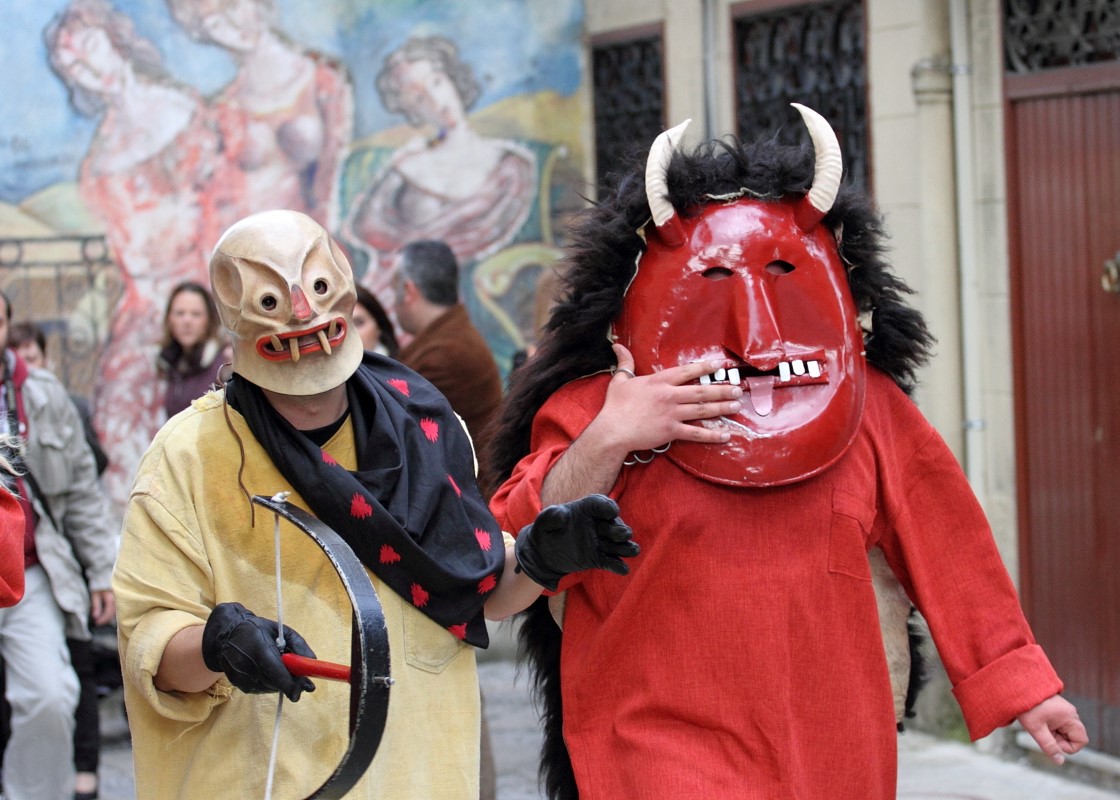
On Easter Sunday, from dawn, the town of Prizzi undergoes a metamorphosis: the inhabitants are awakened by groups of children who knock on their doors. Everyone of these kids is wearing a red dress (the devils) except one who is wearing a yellow ocher one (death).
These entities, which roam up and down the streets waving the chains, ask relatives, friends and everyone they meet, small amounts of money or fresh eggs or sweets as a handout to free themselves from their raucous and insistent presence.
To the joyfulness of the boys is opposed the official group, the one from the organizing committee, made up of specially appointed adults, but still in costume. These are accompanied by an "undercover" (with no costume), who guarantees for them and keep the deals.
The characters are generally three: two represent the demons and one represents death. The devils wear a dyed red outfit, as if to take the color of fire and hell, while on the face they wear an iron mask with a large mouth, from which protrude the tongue and large teeth; the eyes are two small slits which contrast with the big nose. The mask is surmounted by two horns and a goat skin that covers the shoulders and the back of the wearer. The two masks differ for the different colors of the fleece: one is black, the other is white. Both carry pieces of iron chains that are shaken and even bumped against the masks themselves.
Different is the character of death. Although he wears a suit of canvas, but tinged with yellow ocher (typically called "giallu morti di Pasqua", yellow Easter dead) while the mask is made by leather, almost simulating a skull with fangs (called "scagliuna") protruding from his mouth. The death brings up an instrument that looks like a crossbow.
The folk-religious representation of the real "dance of the devils", which is also called "u 'ncontru" (the meeting) because of the reason that we will see later, it starts in the early hours of the afternoon.
The statues of Christ and the Virgin Mary are arranged opposite one another, at a safe distance. Two angels guard each one of them. Meanwhile, all the people rally into the street, and while the band plays gaily, devils and death roam among the people "capturing" the participants, and, metaphorically, their souls. Those captured are dragged "to hell", as to say to one or more premises where they are offered to be freed upon payment of an offering (the offer is free). After the liberation they are also given the typical Easter Prizzi sweets, the so-called "cannateddi", elaborate works of pastry dough with a boiled egg in the center, or a "shot", depending what the "victim" chooses!
Being caught is not that bad: there is in fact those who complain of not being yet and does everything to be kept. Often the "captured" by the devils are forced to dance with them, and so you may find yourself in a circle jumping and dancing with masks following the notes of the band.
The event takes place in a sequential manner in certain parts of the village where the devils, located next to the death, try in every way to prevent the meeting ("u 'ncontru") between the statues of the Risen Christ and the Madonna. This is where the real "dance of the devils" takes place. The ritual begins with the rhythmic notes of the band. The statues begin to reach out to one another while the devils and death run and dance towards each other. The key moment is when the three characters are trapped between the two statues with no way of escape, being then stabbed by the swords of two angels and finally allowing the meeting, thus causing the explosion of joy of the audience.
The current manifestation retains in the traditional characters and objects obvious traces of several layers of past cultures. The characteristic features of the mask of the devil in fact report to the periods of Greek domination.
The significance of the event is about the theme of death linked to the forces of evil: thus a death at the mercy of demonic forces. The arrogance of Evil comes to a point that would prevent and hinder the meeting of the forces of good, it gets strength by the presence of death that tries for some ways to prevent the resurrection of the divine mystery by which Christ has defeated death.
The death, the central part of the event, is purged by the presence of evil during the crucial phase of the meeting, where the two devils are pierced by as many angels, freeing up the death to continue his eternal role but not at the mercy of evil.



